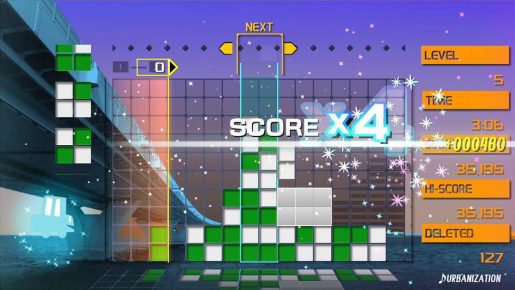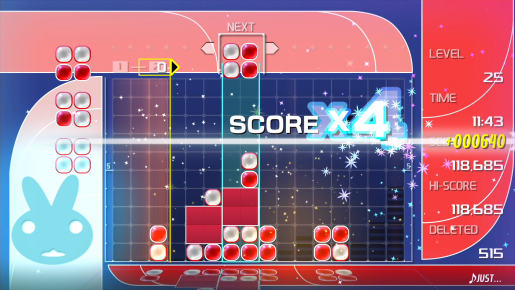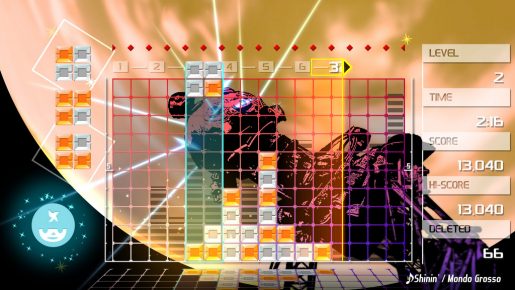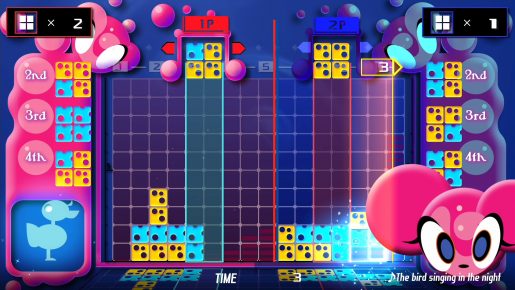Lumines: Puzzle Fusion had a lot going for it when it originally released. In addition to being a launch title for the PlayStation Portable, it was a puzzle game, which does extremely well in a portable setting. Lumines: Puzzle Fusion also stood out by having a simple to learn and hard to master style of play, combined with fascinating and fun songs/levels. Years later Lumines is back with a remaster that tries to bring the fun of the original, to a new generation of gamers. With improved visuals, an online leaderboard and all the things that made the original great, can it compete with current offerings or did it just release at the right time?
There really isn’t much to Lumines Remastered. There is challenge, skin edit, time attack, puzzle, mission and VS battle, all of which offer a different take on the same gameplay. Before we can talk about how they differ, let’s look at how Lumines Remastered is played.
Players are given a block comprised of four smaller cubes that can be one of two colors. They come in every configuration, so one solid color, two and two (one version has the same color on one side, where as another version has alternating colors) and three and one. Players need to stack these blocks so they make a square of the same color. The hard part is not making endless chains of one, but rather, linking enough blocks where you can create a massive chain. How this works is simple, yet complicated.
Basically, every square counts as one, so if you get one chain, adding two blocks in any direction will create a second square, since the overlapping part counts as part for both sides. Things start to be crazy when you, start to maximize your potential. A good example of this is when you make a simple square, add two blocks on to for a two chain, followed by two on the side for a three chain and then add a single block between the two. This will create another block, and it keeps going from there. As you create these blocks a line will be going across the screen and clearing any chains, so you have however long to create these chains before having to restart. Since this covers the basics, let’s talk about how every mode approaches it.
Challenge is essentially an endless mode where you move between various skins (designs and songs), which offer different challenges. Since every song has different visuals, which can make it easier or harder to link them together, and its own clear speed, they have distinct advantages and disadvantages. So, a faster song is hard to create large combos, while also making it hard to lose. The opposite is true for slow songs, as you can build a bigger combo, but if you create too big of one you might end up losing enough space to ultimately fail.
Skin edit takes the basic idea of challenge and instead of following the games predetermined order, players can play up to 10 skins, in whatever order they so desire. The advantage here is some skins are unique to other modes, meaning you won’t see them in challenge and/or require so much time to get to that it isn’t feasible to play challenge to experience.
While time attack is little more than seeing how many squares you can clear in a given time, puzzle is arguably one of the hardest and unique modes in the game. Puzzle requires players to create a specific shape and only that shape. So, if you create it and you have an extra block, you need to clear that block, while maintaining the shape, or you’ll fail. What makes it hard isn’t just creating the shape, but also making sure you don’t accidentally break anything. I’ve failed a lot of runs because I created the shape, carelessly destroyed some blocks and couldn’t salvage the run.
Those looking for simpler tasks will likely enjoy mission mode. Instead of having to create a specific shape, players need to perform a predetermined task under certain conditions. Even on easy these require some forethought, with a good example of what I mean being the fourth one. Here players need to clear every block in two moves, with two blocks on the ground (one side is four white and the other four orange) using two blocks of the same configuration. The most obvious move would be to directly match one color and then clear the remaining by going between, but that isn’t the solution. The solution is to pick a side and set the opposite color on top of one side, with the corresponding color going over the edge. It will drop, creating a block and the destruction of that block will bring the aforementioned opposite color down, creating another block. Do it again and you’ll clear the stage.
Versus is the final and most frustrating mode in the game. Where it might be enjoyable playing against a friend, the AI can be brutal and will often require players to move at a speed that is either unenjoyable or causing them to make multiple mistakes. This is because both sides start with half the board and they need to clear the most blocks during a pass-through to gain one line more of space to work with. This is important, since it’s almost impossible to win or even come back if you lose most of the board. Where it gets annoying is the AI has the right side, meaning they have more time to get the first attack and will often times maintain a good rate of two or three per turn, a sum you either need to match or exceed if you want to win.
Verdict
Lumines Remastered’s enjoyment is largely dependent on your ability and interest in achieving high scores and/or think about things creatively. This makes it hard to judge, since the only mode with outside factors is versus. Even though that mode can be, in a word, brutal, the other modes offer more than enough content to have an enjoyable experience. It’s also so simple that, even if you can’t achieve insane combos, even a terrible player can last a while if they’re good enough at managing their workspace. So, if you’re looking for a puzzle game or something to do on the go, Lumines Remastered is a fantastic choice.
[Editor’s Note: Lumines Remastered was reviewed on PS4 platform. The game was provided to us by the publisher for review purposes.]





